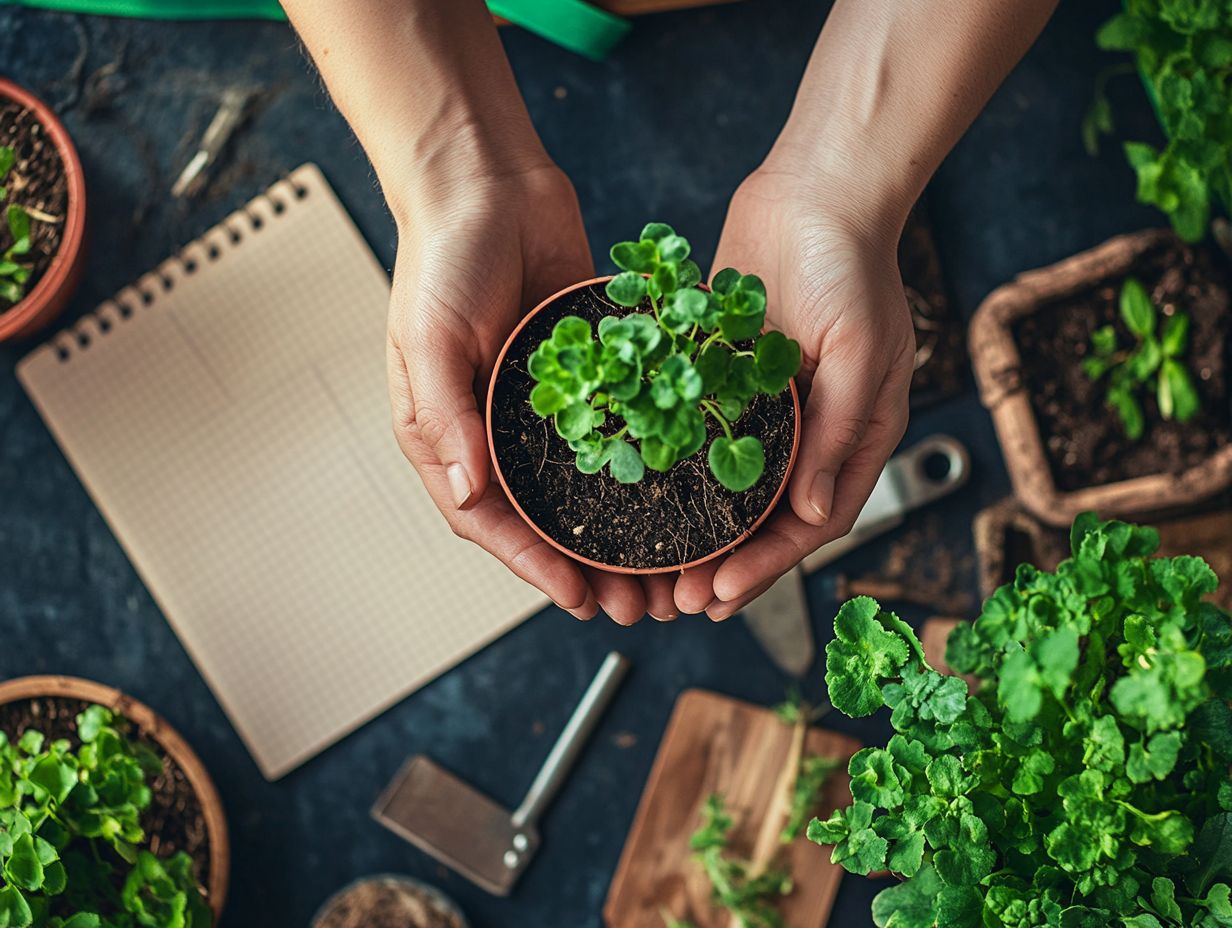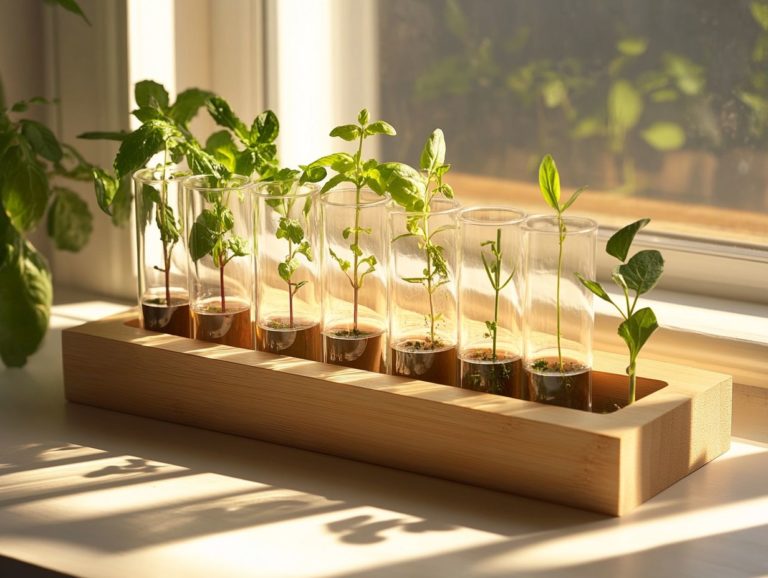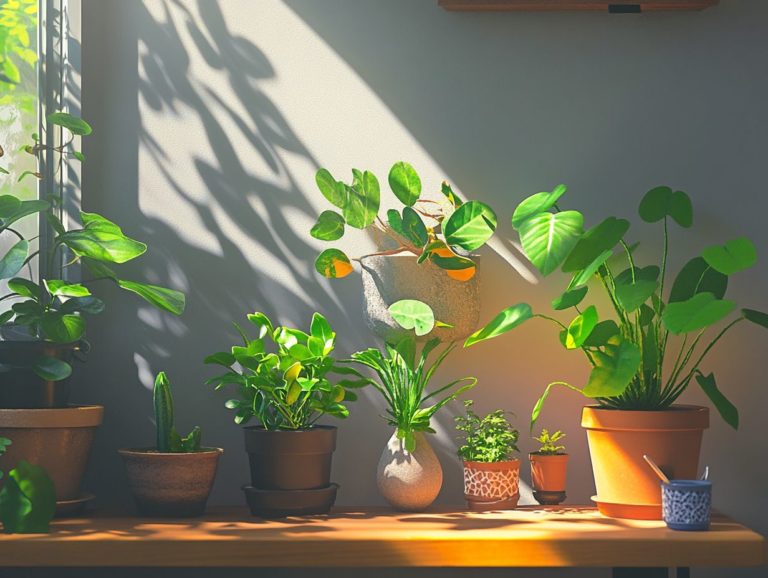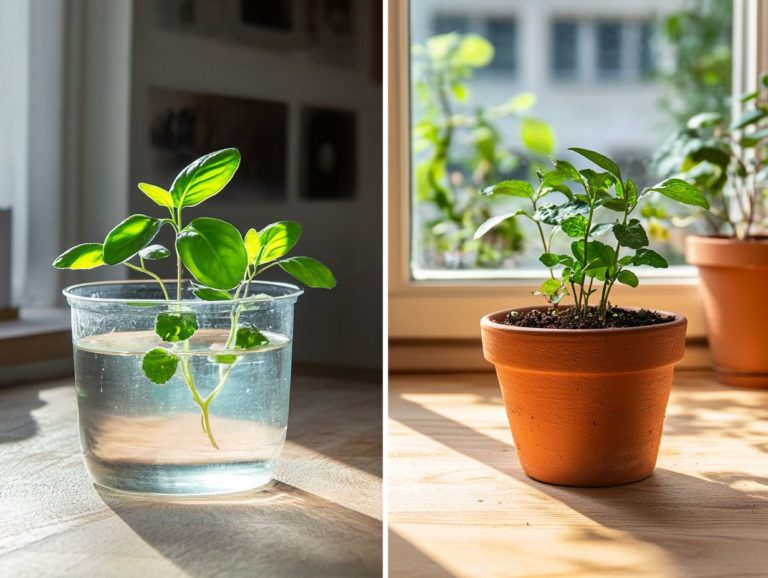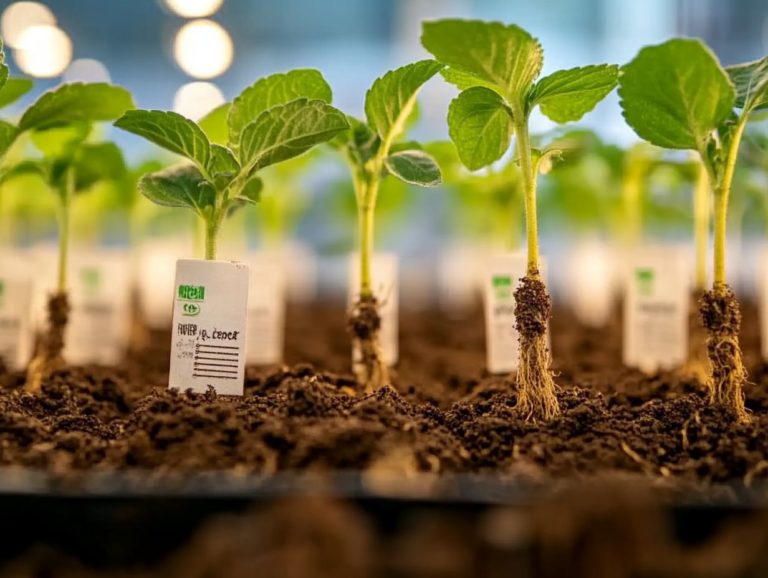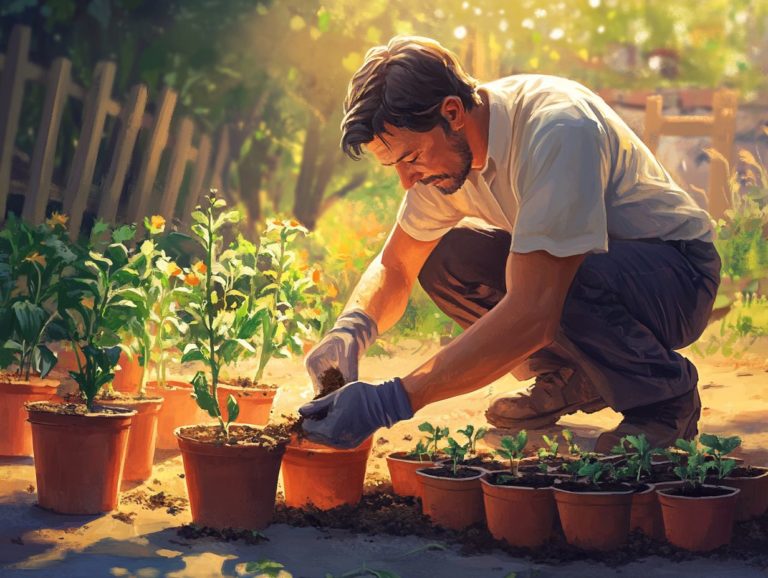5 Mistakes to Avoid When Propagating Plants
Plant propagation is a rewarding journey, but it can present its fair share of challenges. Recognizing the common pitfalls can transform your experience, whether you re a seasoned gardener or just embarking on this green adventure.
Here, you ll discover five crucial mistakes to avoid while propagating your plants, along with essential tools, methods, and indicators of success. Dive in to learn how to ensure your plant propagation efforts blossom beautifully!
Contents
- Key Takeaways:
- 1. Using the Wrong Type of Soil
- 2. Not Providing Enough Light
- 3. Over or Underwatering
- 4. Not Sterilizing Equipment
- 5. Not Giving Enough Time for Roots to Develop
- What is Plant Propagation and Why Is It Important?
- Frequently Asked Questions
- 1. What are the top 5 mistakes to avoid when propagating plants?
- 2. How can overwatering affect the success of plant propagation?
- 3. What type of soil should be used when propagating plants?
- 4. Why is providing enough light important for propagating plants?
- 5. How can using dull or dirty tools affect plant propagation?
- 6. What are some steps to properly prepare a plant for propagation?
Key Takeaways:
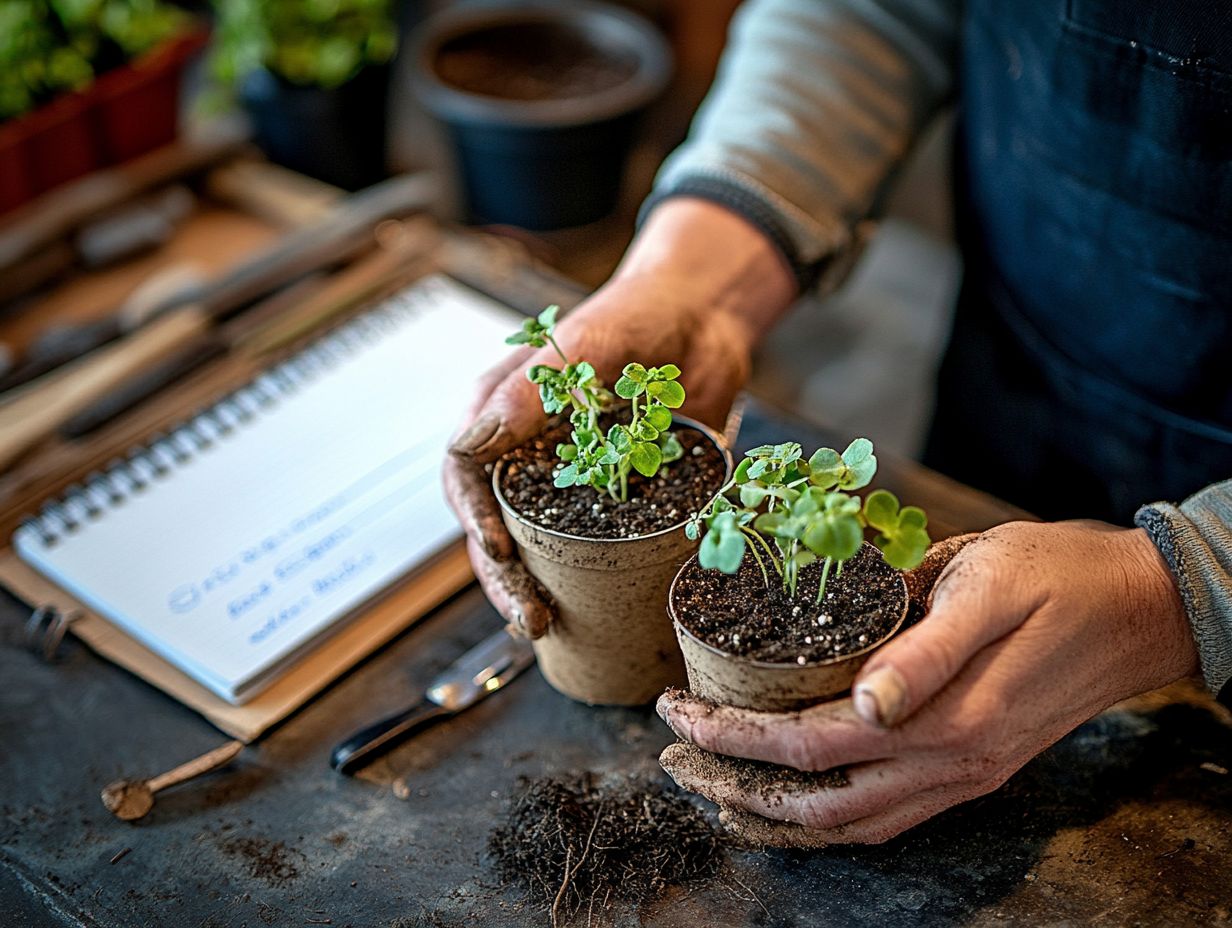
- Use appropriate soil for successful plant propagation soil should be well-draining and nutrient-rich.
- Provide adequate light for plants to thrive research the light needs of the specific plant being propagated.
- Avoid over or underwatering monitor soil moisture and adjust watering accordingly.
1. Using the Wrong Type of Soil
Using the wrong type of soil can hinder your plants’ growth. It impacts everything from root development to overall vitality.
The choice of soil directly influences essential factors like how well the soil holds water, nutrient availability, and drainage critical for thriving plants.
By understanding the specific needs of your plants, such as their light and humidity requirements, you can select the best compost type to ensure optimal growth.
For instance, seedlings thrive when you use seed compost, specifically formulated to provide necessary nutrients for young plants. This fosters strong, healthy root systems while ensuring adequate drainage.
On the other hand, potting soil designed for houseplants can significantly enhance their development. It typically contains a balanced mix of nutrients tailored to support a variety of indoor species.
Choosing the right soil not only nourishes your plants but also creates a thriving environment for growth. Ultimately, this leads to a flourishing indoor garden.
2. Not Providing Enough Light
Insufficient light is a frequent pitfall in indoor gardening. It often results in stunted growth and plants that simply refuse to thrive.
Understanding the varying light requirements of your houseplants is essential; whether they prefer low light or brighter conditions can make all the difference in their success.
Without the right amount of light, you may notice weak growth habits, leaving your plants more vulnerable to pests and diseases. To ensure optimal light conditions, identify the specific needs of each species.
For example, snake plants and pothos thrive in lower light, making them perfect for corners in rooms or offices. In contrast, succulents and cacti bask in direct sunlight, so positioning them near south-facing windows will give them the intensity they crave.
In tricky spots where natural light is lacking, utilizing grow lights can be a game-changer. These lights offer a customizable spectrum that can effectively mimic sunlight. Regularly rotating your plants ensures that all sides receive equal light, promoting balanced growth and overall vitality.
3. Over or Underwatering
Overwatering and underwatering are common pitfalls that can significantly affect your plants’ health. They can lead to unfortunate issues like root rot (a plant disease caused by excess water) or desiccation (drying out).
To truly master the art of watering, it’s essential to understand the specific moisture needs of each plant. It’s also important to recognize when they signal their need for water.
Consider factors such as soil type, temperature, and humidity levels. These elements are crucial in crafting an effective watering schedule that promotes robust root systems and overall plant vitality.
To assess soil moisture accurately, techniques like the finger test can be useful. Simply insert your finger into the soil about two inches this reveals its dampness at a glance.
For a more precise measurement, moisture meters can be invaluable, indicating whether your soil is too dry or overly wet. Remember, different plants have distinct watering needs; for instance, succulents flourish with infrequent watering, while leafy greens often crave consistent moisture.
By tailoring your watering schedules to fit the growth habits of your plants, you ll cultivate a thriving garden, avoiding both waterlogged conditions and thirsty foliage.
4. Not Sterilizing Equipment
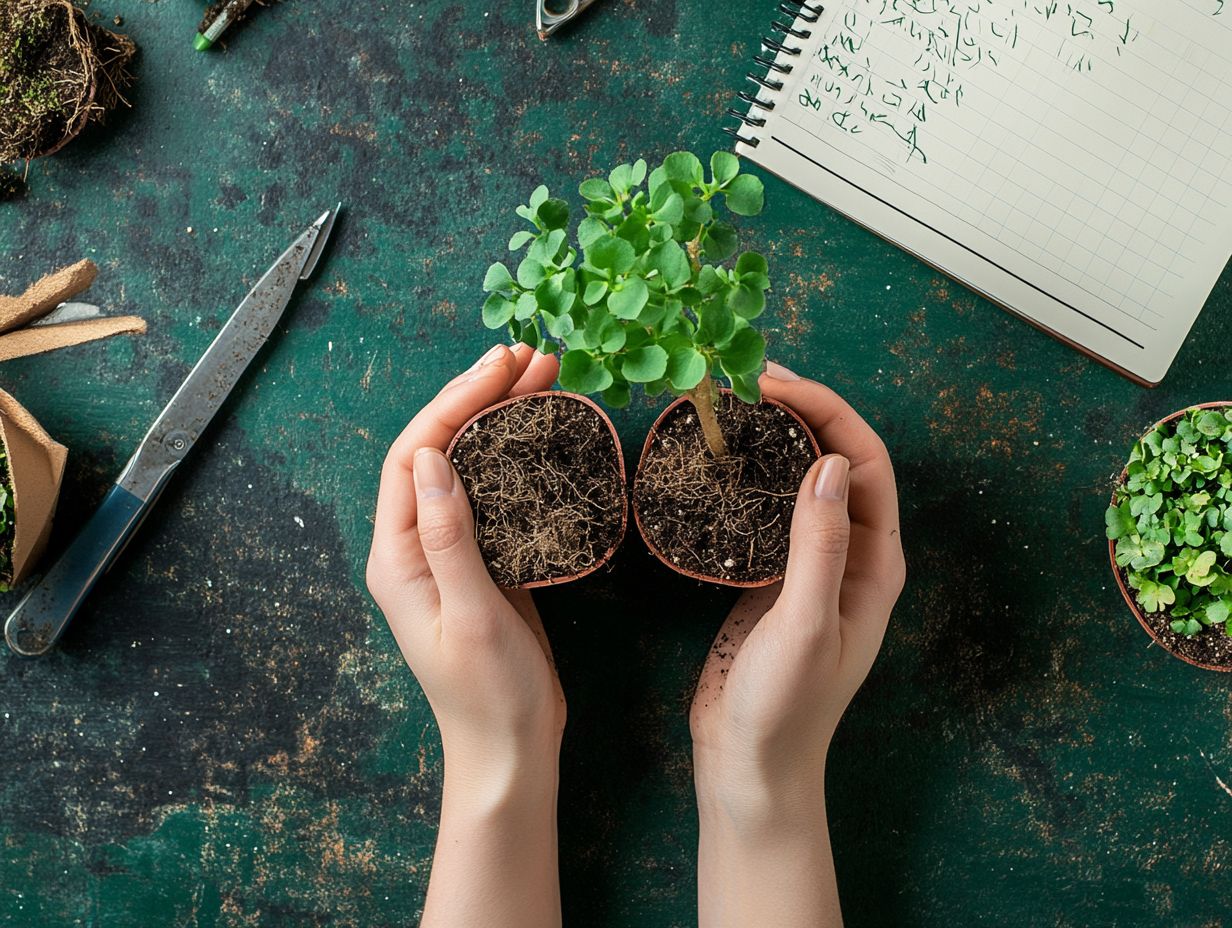
Neglecting to sterilize your gardening tools is a big mistake that can open the door to pests and diseases in your garden. Meticulously cleaning all cutting tools, including pruning shears and propagation supplies, protects your plants. This practice encourages healthier growth.
Regular maintenance of your equipment amplifies the effectiveness of your gardening efforts.
There are various methods for effectively sterilizing your tools. Adopting these practices is essential for any dedicated gardener.
- Mix 10% bleach or rubbing alcohol to quickly kill germs on your tools.
- Soaking your tools in hot, soapy water followed by a thorough rinse keeps them clean and ready for action.
Steam sterilization is also an efficient method, ensuring that even the tiniest crevices are properly disinfected. Using these cleaning methods will protect your plants and help them thrive!
5. Not Giving Enough Time for Roots to Develop
Allowing sufficient time for roots to establish is essential for your plant propagation success. Premature transplanting can lead to stunted growth and a lack of vigor. Proper root establishment is crucial; it directly impacts your plants’ ability to absorb water and nutrients from the soil.
By understanding the growth timeline of your cuttings and adhering to effective ways to grow plants, you set your plants up for long-term health.
Patience during this process is key; it plays a vital role in nurturing a vibrant garden.
Softwood cuttings usually root in two to four weeks. In contrast, hardwood cuttings can take several months.
To keep track of root development, using transparent containers is a smart move. This way, you can easily observe without disturbing the plants. Watch for signs like new growth or changes in how much water your plants need these can indicate the perfect moment for transplanting.
Staying attentive to these growth stages not only helps you avoid mishaps but also enhances your overall gardening experience.
What is Plant Propagation and Why Is It Important?
Plant propagation saves you money! Instead of buying new plants, you can grow new ones from your existing collection. This essential practice enriches biodiversity and nurtures healthier ecosystems.
By mastering various propagation methods and techniques, you can multiply your favorite houseplants, ensuring your collection flourishes and creating an optimal growth environment.
This practice deepens your connection with nature and opens the door to sharing and exchanging vibrant plants with fellow enthusiasts, enriching the gardening community.
Methods like leaf cuttings, stem divisions, and even water propagation are straightforward and require minimal resources and space, making them ideal for indoor gardening.
For example, by taking cuttings from a Pothos, you can effortlessly generate several new plants that thrive even in low-light conditions. These techniques enhance the diversity of plant life in your personal space and contribute to eco-friendly practices.
Start propagating today and enjoy a thriving, eco-friendly garden!
What Are the Different Methods of Plant Propagation?
There are several effective methods of plant propagation at your disposal, tailored to suit various plants and desired outcomes. Techniques like cuttings and division each have their own nuances, allowing you to choose the most appropriate approach for your garden. For instance, taking cuttings from houseplants like African violets or ZZ plants provides a straightforward means to expand your collection. This technique also promotes strong roots.
Consider division for perennial plants such as hostas and daylilies. This technique involves carefully separating a mature plant into smaller sections, each complete with roots. This enables quick establishment in new locations. Timing is everything! Try to divide your plants in early spring or fall when the plants are actively growing or entering dormancy.
If you prefer to start from scratch, seed germination is your go-to method. You can choose from easy-to-grow options like sunflowers or tackle more intricate varieties such as orchids. Successful germination demands your careful attention to temperature, moisture, and light conditions, which can vary significantly among different plant species.
What Are the Essential Tools and Materials for Plant Propagation?
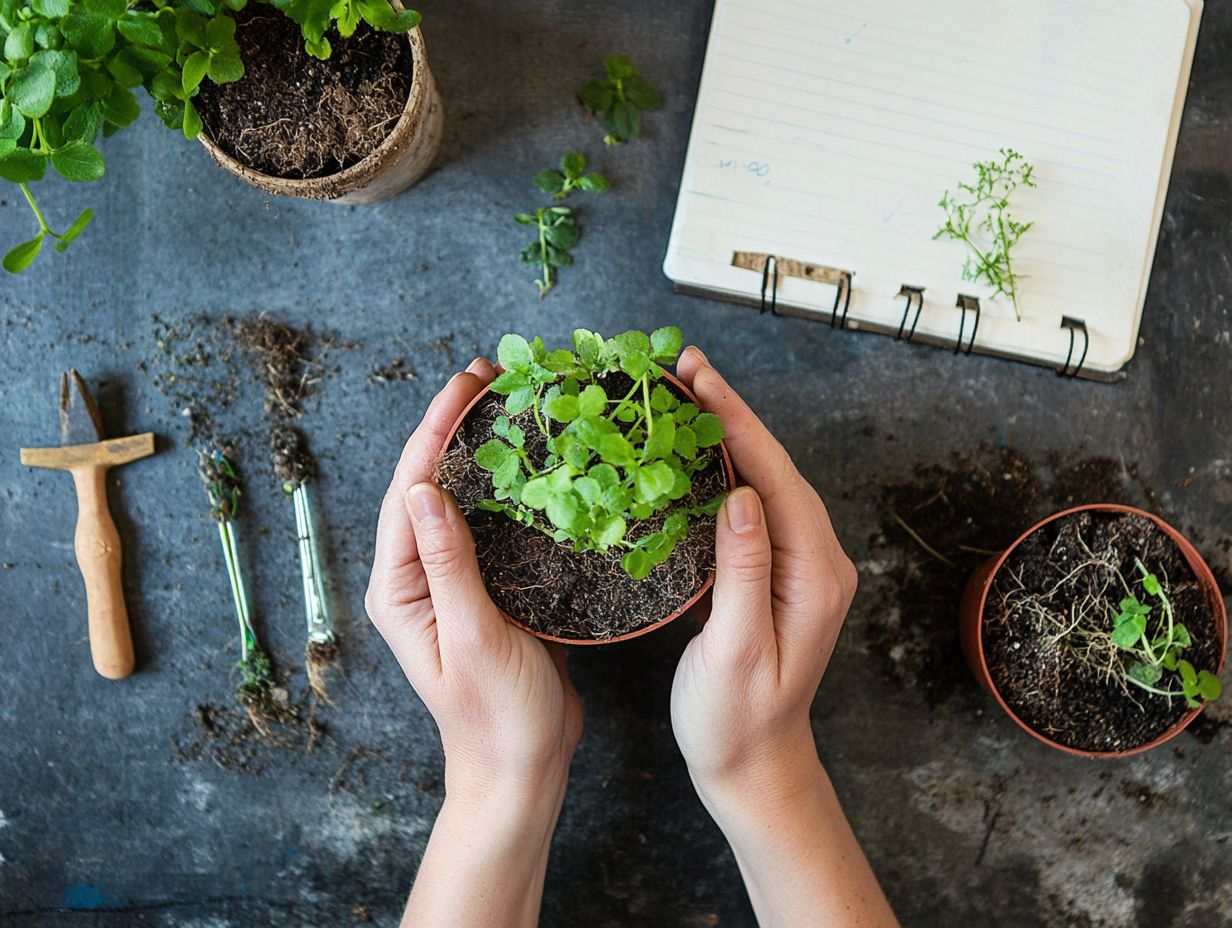
Equipping yourself with the right tools and materials is essential for successful plant propagation, allowing for a smoother and more efficient process.
Consider using rooting hormone a substance that helps cuttings grow roots faster. This can significantly boost the chances of your cuttings developing strong roots. A spray bottle is invaluable for maintaining ideal moisture levels without drowning the cuttings. Quality containers are also a must, as they provide the necessary drainage to prevent waterlogging and root rot.
Investing in high-quality compost enriched with nutrients ensures that your young plants receive the optimal support they need as they grow. By focusing on top-notch materials and utilizing them correctly, you can create a thriving environment that fosters successful propagation.
What Are the Common Mistakes Made When Propagating Plants?
Common mistakes in plant propagation can often lead to disappointing results. They may stunt the growth of healthy plants and dishearten even the most enthusiastic beginner gardeners. Whether it s underestimating the importance of light and humidity or neglecting the right soil composition, understanding these pitfalls is essential for successful propagation. By identifying these missteps and learning from them, you can refine your techniques, resulting in stronger root systems and more vibrant plants.
Many novices overlook the critical role of adequate lighting. This can lead to leggy cuttings that struggle to flourish. Employing grow lights, especially during the darker months, can significantly boost growth.
While choosing potting soil may seem straightforward, opting for a well-draining mix can make all the difference. This will prevent waterlogged roots that spell disaster.
Overwatering is another frequent blunder. It s wise to allow the topsoil to dry out slightly before the next watering, ensuring your cuttings receive just the right amount of moisture.
By tackling these common oversights, even those new to gardening can cultivate a healthy propagation practice and truly enjoy their planting journey.
What Are the Signs of a Successful Plant Propagation?
Recognizing the signs of successful plant propagation is essential for understanding when your efforts have truly paid off and for ensuring the health of your new plants.
As you observe the intricate network of roots developing within the potting medium, take note this is a crucial indicator of success. These roots provide the anchor and nutrients necessary for future growth. Look for vibrant new leaves unfurling, which signals that your plants are robustly establishing themselves in their new environment.
To nurture these promising beginnings, ensure proper light exposure, maintain consistent moisture levels, and apply a balanced fertilizer. This can significantly enhance their growth trajectory. Regularly check for pests and diseases to maintain the health of your young specimens, ensuring they thrive as they continue to mature.
How Can One Ensure Success in Plant Propagation?
Want to succeed in plant propagation? It takes the right techniques, the perfect environment, and a little TLC to watch your plants thrive!
Ensuring your success in plant propagation requires a blend of proper methods, environmental considerations, and attentive care. By grasping the specific needs of various plant species like humidity levels, light requirements, and nutrient availability you can create ideal conditions for rooting and growth.
Tailoring effective plant propagation methods to each plant significantly boosts your chances of cultivating robust and thriving new specimens.
One crucial aspect to monitor is temperature, as most plants prefer a warm environment, typically between 65 F and 75 F. Humidity is also a vital factor; employing misting or a mini greenhouse can help sustain the moisture levels that delicate cuttings need.
Adjusting light according to the type of plant is equally important. Some cuttings thrive in bright, indirect light, while others prefer low-light conditions. For instance, when propagating succulents, you ll find they need less moisture and brighter light, whereas ferns flourish in higher humidity.
By fine-tuning these environmental factors, you can create the perfect sanctuary for your fledgling plants to thrive.
Frequently Asked Questions
1. What are the top 5 mistakes to avoid when propagating plants?
The top 5 mistakes to avoid when propagating plants are overwatering, using the wrong type of soil, not providing enough light, using dull or dirty tools, and not properly preparing the plant for propagation.
2. How can overwatering affect the success of plant propagation?
Overwatering can cause the plant to rot or develop fungal diseases, which can prevent successful propagation. Water your plant only when the soil feels dry to help prevent root rot and encourage healthy growth!
3. What type of soil should be used when propagating plants?
The best soil for plant propagation is a well-draining mix specifically designed for this purpose. Avoid using regular potting soil, as it may be too heavy and can hold too much moisture, leading to root rot.
4. Why is providing enough light important for propagating plants?
Plants need light to photosynthesize and grow, especially during propagation when they are developing new roots. Insufficient light can hinder growth and lead to weak or leggy plants.
5. How can using dull or dirty tools affect plant propagation?
Dull or dirty tools can damage the plant’s stem or leaves, making it more difficult for the plant to develop new roots. Always use clean and sharp tools when taking cuttings for propagation.
6. What are some steps to properly prepare a plant for propagation?
To prepare a plant for propagation, choose a healthy and mature plant. Disinfect your tools, take cuttings from the plant’s stem or leaves, remove any flower buds or fruit, and dip the cut end of the plant in rooting hormone before planting in soil.
Ready to start your propagation journey? Dive in and grow those plants!
By applying these tips, you’ll be well on your way to successful plant propagation!

